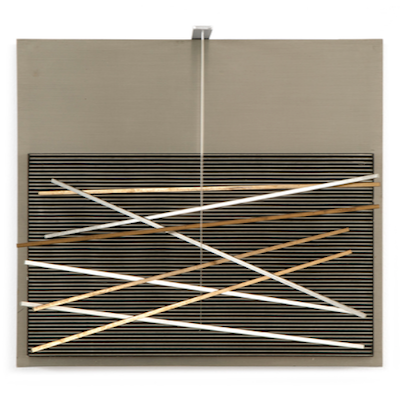
Details
Artist
Styles
Untitled (Rulers III), 2011 - Photo gravure and emboss - 4 plates of 8 x 12 cm. -Printed on Zerkall-Butten, 450 gr. of 27 x 40 cm. Edition of 11 // Rita McBride's Untitled (Rulers III) (2011) is a vibrant photogravure that uses everyday objects to create an abstract and layered composition. The focal point is a yellow measuring tape laid against a textured, colorful surface with bold hues of green, red, and black. The interaction between the ruler’s clear numerical markings and the vivid abstract background introduces a contrast between measurement and organic forms, highlighting themes of precision versus spontaneity. Printed on Zerkall-Butten paper, this work combines photogravure and embossing techniques, adding depth and tactility. Untitled (Rulers III) reflects McBride's fascination with utilitarian objects transformed into visual art.
Untitled (Rulers III), 2011
form
Medium
Size
27 x 40 cm
- Inches
- Centimeters
Edition
Price
- USD
- EUR
- GBP
Details
Artist
Styles
Untitled (Rulers III), 2011 - Photo gravure and emboss - 4 plates of 8 x 12 cm. -Printed on Zerkall-Butten, 450 gr. of 27 x 40 cm. Edition of 11 // Rita McBride's Untitled (Rulers III) (2011) is a vibrant photogravure that uses everyday objects to create an abstract and layered composition. The focal point is a yellow measuring tape laid against a textured, colorful surface with bold hues of green, red, and black. The interaction between the ruler’s clear numerical markings and the vivid abstract background introduces a contrast between measurement and organic forms, highlighting themes of precision versus spontaneity. Printed on Zerkall-Butten paper, this work combines photogravure and embossing techniques, adding depth and tactility. Untitled (Rulers III) reflects McBride's fascination with utilitarian objects transformed into visual art.
- Recently Added
- Price (low-high )
- Price (high-low )
- Year (low-high )
- Year (high-low )
What is kinetic art?
Kinetic art is an international movement that emerged in the 1920s and gained prominence in the 1960s, referring to art that involves both apparent and real motion. It encompasses any medium that includes movement, either relying on actual motion for its effect or being perceived as moving by the viewer. Early examples include canvas paintings designed to create optical illusions of movement. Today, kinetic art often refers to three-dimensional figures and sculptures, such as those operated by machines or those that move naturally. The movement covers a variety of styles and techniques that frequently overlap.



















